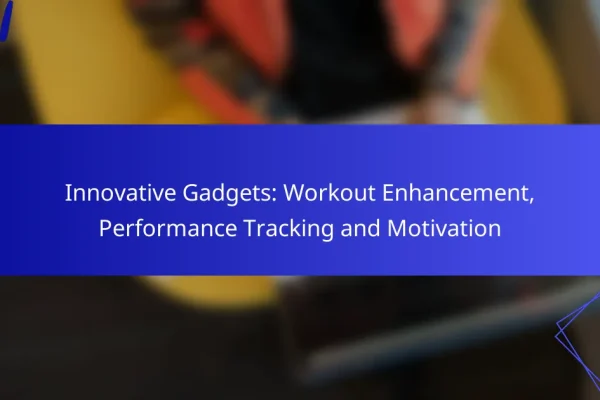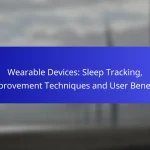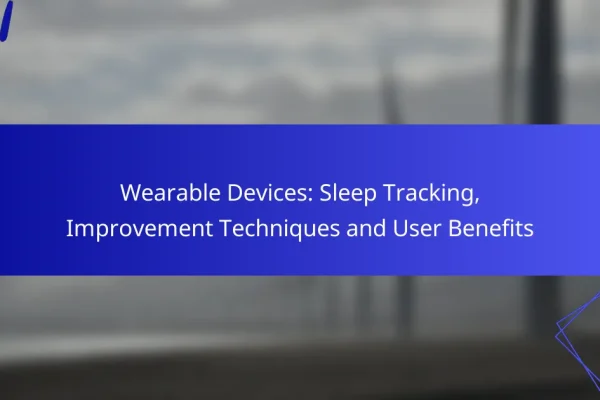What are the best wearable technology gadgets in 2023?
The best wearable technology gadgets in 2023 include devices that offer advanced health tracking, seamless connectivity, and user-friendly interfaces. Key players like Apple, Fitbit, Samsung, Garmin, and Oura have released products that cater to various fitness and lifestyle needs.
Apple Watch Series 8
The Apple Watch Series 8 stands out for its comprehensive health monitoring features, including heart rate tracking, ECG, and blood oxygen levels. It also offers a robust suite of apps for fitness, communication, and productivity, making it a versatile companion for daily use.
With a bright display and customizable watch faces, the Series 8 allows users to personalize their experience. Battery life typically lasts up to 18 hours, which is adequate for most users, but heavy app usage may require more frequent charging.
Fitbit Charge 5
The Fitbit Charge 5 is a fitness tracker that excels in health metrics, offering features like stress management, sleep tracking, and built-in GPS. It is designed for those who prioritize fitness and wellness, providing insights into daily activity levels and heart health.
Its battery can last up to seven days, making it convenient for continuous monitoring without frequent recharging. The Charge 5 also integrates with the Fitbit app for detailed analysis and goal setting, enhancing user engagement.
Samsung Galaxy Watch 5
The Samsung Galaxy Watch 5 combines stylish design with advanced health tracking capabilities, including body composition analysis and sleep coaching. It is particularly beneficial for Samsung smartphone users due to its seamless integration with the Galaxy ecosystem.
With a battery life of around 40 hours, it supports a variety of fitness activities and offers customizable watch faces. The watch also includes features like notifications and music control, making it a practical choice for everyday wear.
Garmin Venu 2
The Garmin Venu 2 is tailored for fitness enthusiasts, featuring GPS tracking, animated workouts, and health monitoring tools. Its vibrant AMOLED display enhances visibility during outdoor activities, and it supports a wide range of sports modes.
Battery life can extend up to 11 days in smartwatch mode, which is advantageous for users who prefer longer intervals between charges. The Venu 2 also provides insights into recovery and training status, helping users optimize their fitness routines.
Oura Ring Generation 3
The Oura Ring Generation 3 offers a unique approach to wearable technology by providing health tracking in a ring form factor. It focuses on sleep quality, readiness, and activity levels, making it ideal for users who prefer a less obtrusive device.
With a battery life of about seven days, the Oura Ring is lightweight and comfortable for continuous wear. Its app provides personalized insights and recommendations, helping users improve their overall wellness and lifestyle habits.
How do wearable gadgets improve health and fitness?
Wearable gadgets enhance health and fitness by providing real-time data and insights that help users monitor their physical well-being. These devices track various health metrics, enabling individuals to make informed decisions about their lifestyle and fitness routines.
Heart rate monitoring
Heart rate monitoring is a fundamental feature of many wearable gadgets, allowing users to track their heart rate during different activities. This data can help assess cardiovascular fitness and inform users when to push harder or take a break. Most devices provide continuous heart rate tracking, which can be particularly useful during workouts.
When choosing a wearable, consider the accuracy of heart rate sensors. Devices that use optical sensors tend to be more common, but some users may prefer chest strap monitors for higher precision during intense exercise.
Sleep tracking
Sleep tracking features in wearable technology help users understand their sleep patterns and quality. By monitoring sleep stages, duration, and disturbances, these devices can provide insights into how well one is resting. This information can be crucial for improving overall health and optimizing recovery.
To make the most of sleep tracking, set a consistent sleep schedule and review your sleep data regularly. Look for trends over time, such as how late-night screen time affects your sleep quality.
Activity reminders
Activity reminders are designed to encourage users to stay active throughout the day. Wearable gadgets can send alerts to remind users to move if they have been sedentary for too long. These nudges can be effective in promoting a more active lifestyle.
To maximize the benefits of activity reminders, customize the frequency and type of alerts based on personal goals. For example, setting reminders to stand or stretch every hour can help break up long periods of inactivity.
Stress management features
Many wearable devices now include stress management features that help users monitor and reduce stress levels. These may involve guided breathing exercises, mindfulness sessions, or tracking physiological indicators like heart rate variability. Such tools can be beneficial for maintaining mental well-being.
To effectively use stress management features, engage with the provided exercises regularly and pay attention to how your body responds. Consider combining these features with other relaxation techniques, such as yoga or meditation, for a holistic approach to stress reduction.
What are the key features to consider when buying wearable technology?
When purchasing wearable technology, it’s essential to evaluate features that impact usability and functionality. Key aspects include battery life, compatibility with smartphones, water resistance rating, and health tracking capabilities.
Battery life
Battery life is a critical factor in wearable technology, as it determines how often you need to recharge the device. Many wearables offer battery life ranging from a couple of days to several weeks, depending on usage and features. Consider your lifestyle and how often you can recharge your device.
For example, fitness trackers may last longer than smartwatches due to fewer power-intensive features. Look for devices with quick charging options if you have a busy schedule.
Compatibility with smartphones
Ensure that the wearable technology is compatible with your smartphone’s operating system, whether it’s iOS or Android. Some devices may offer limited functionality if they are not paired with the right platform. Check the manufacturer’s specifications for compatibility details.
Additionally, consider the app ecosystem associated with the wearable. A robust app can enhance the experience by providing more features and better integration with other services.
Water resistance rating
The water resistance rating indicates how well a wearable can withstand exposure to moisture. Look for devices with at least an IP67 rating, which means they can handle dust and immersion in water up to one meter for a limited time. This is crucial for wearables intended for swimming or outdoor activities.
Higher ratings, such as IP68, offer even better protection, allowing for deeper water exposure. Always check the manufacturer’s guidelines for specific activities that the device can handle.
Health tracking capabilities
Health tracking capabilities vary widely among wearable devices. Basic models may only track steps and calories, while advanced wearables can monitor heart rate, sleep patterns, and even blood oxygen levels. Identify which health metrics are most important for your needs.
Some wearables also offer features like ECG monitoring and stress tracking, which can be beneficial for users with specific health concerns. Make sure to review the accuracy and reliability of the health tracking features before making a purchase.
What are the top brands in wearable technology?
The leading brands in wearable technology include Apple, Fitbit, Samsung, and Garmin. Each of these companies offers unique features and functionalities that cater to different user needs, from fitness tracking to smart notifications.
Apple
Apple is renowned for its Apple Watch, which integrates seamlessly with other Apple devices. It offers features like heart rate monitoring, ECG, and a wide range of apps, making it a versatile choice for users who prioritize connectivity and health tracking.
Consider the Apple Watch Series 8 for its advanced health features and the Apple Watch SE for a more budget-friendly option. Both models support various bands and styles, allowing for personalization.
Fitbit
Fitbit specializes in fitness tracking and health monitoring, making it a popular choice for health-conscious consumers. Devices like the Fitbit Charge and Versa series provide insights into daily activity, sleep patterns, and heart health.
Fitbit’s user-friendly app enhances the experience by tracking fitness goals and offering challenges. The brand is known for its affordability, with options ranging from basic fitness bands to more advanced smartwatches.
Samsung
Samsung’s Galaxy Watch series combines fitness tracking with smart features, appealing to Android users. The Galaxy Watch 5, for example, includes advanced health metrics like body composition analysis and sleep tracking.
Samsung devices are compatible with a wide range of Android smartphones, making them a practical choice for users in the Android ecosystem. They also offer a variety of styles and sizes to suit different preferences.
Garmin
Garmin is a leader in GPS technology and is favored by outdoor enthusiasts and athletes. Their wearables, such as the Forerunner and Fenix series, provide detailed tracking for running, cycling, and other sports.
Garmin devices are known for their durability and long battery life, making them ideal for extended outdoor activities. They often include features like navigation and performance metrics, catering to serious athletes and adventurers.
How do wearable gadgets enhance daily life?
Wearable gadgets enhance daily life by providing real-time data and feedback on health, fitness, and connectivity. These devices, such as smartwatches and fitness trackers, help users monitor their well-being, stay organized, and remain connected without needing to check their phones constantly.
Health Monitoring
Wearable technology plays a crucial role in health monitoring by tracking vital signs like heart rate, sleep patterns, and physical activity. Devices can alert users to irregularities, encouraging proactive health management. For instance, many fitness trackers offer reminders to move if users have been inactive for extended periods.
Fitness Tracking
Fitness tracking is one of the most popular applications of wearable gadgets. These devices can record steps, calories burned, and workout intensity, helping users set and achieve fitness goals. Many models also provide insights into exercise performance and recovery, allowing for more informed training decisions.
Connectivity and Notifications
Wearable gadgets enhance connectivity by allowing users to receive notifications directly on their wrists. This feature enables quick access to messages, calls, and app alerts without needing to pull out a smartphone. Users can customize which notifications they receive, helping to manage distractions effectively.
Customization and Personalization
Many wearable devices offer customization options, allowing users to tailor their experience. From changing watch faces to selecting specific health metrics to track, personalization enhances user engagement. Some devices even allow for app integration, enabling users to access their favorite services directly from their wearables.







